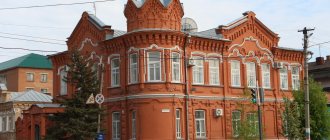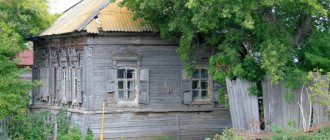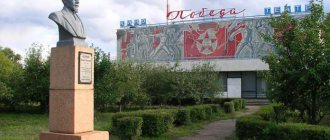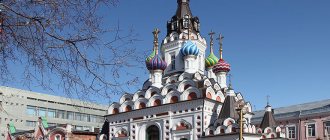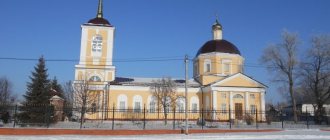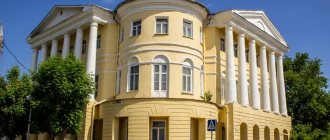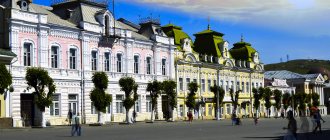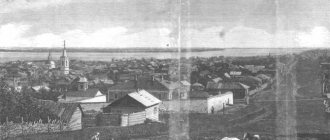Novouzensk
(Saratov region)
OKATO code:
63230501
Founded:
1760
City since:
1835 City of district subordination (Novouzensky district, Saratov region)
Center:
Novouzensky district
The city was formerly called:
| Chertanla | 1760 | 1835 |
| Telephone code (reference phone) | |
| 84562***** | 91-2-80 |
Deviation from Moscow time, hours:
1
Geographical latitude:
50°27′
Geographical longitude:
48°09′
Altitude above sea level, meters:
25 Sunrise and sunset times of the Sun and Moon in the city of Novouzensk
How old is Novouzensk?
07/06/2018 It would seem that there is nothing complicated in the answer to this question. Every year, in the first autumn days, city residents dedicate a big colorful holiday to the next anniversary of the formation of the district and the city of Novouzensk. This year we will celebrate the 90th anniversary of the formation of the district and the abolition of Novouzensky district as a territorial unit. This happened on July 23, 1928. Everything is clear here and no questions arise. Another thing is how old Novouzensk itself is. In recent years, the date of its foundation is called 1835. This date is also indicated on the stele at the entrance to the city. On December 18, 1835, Emperor Nicholas I signed a Decree according to which three new districts should be formed in the Saratov Trans-Volga region - Nikolaevsky, Novouzensky and Tsarevsky. The administrative center of Novouzensky district was determined to be the village of Chertanla, which received the status of a city and was renamed Novy Uzen (later Novouzensk). Based on this, it would be fair to say that 1835 is not the year of the formation of Novouzensk, but the year the village of Chertanla received the status of a city and was renamed.
Any populated area, be it a farmstead or a village, a town or an urban settlement, a city, traces its chronology from the time of its foundation. Confirmation of the founding date is: the first mention in written sources, the first indication on geographical maps, if there are no written sources. Artifacts and other sources found during archaeological excavations can also confirm the period of the founding of a settlement.
The date of foundation does not change depending on the current status of the settlement - village or city. And it does not depend on how this status changed: there was a village - it became a city, there was a city - it became a workers' settlement or village.
Based on this, the founding date of the city of Novouzensk as a populated area should be considered the year the village of Chertanla was founded. Such a year is 1760.
Many sources indicate that the village of Chertanla was founded in the 18th century. In the Encyclopedic Dictionary of F.A. Brockhaus and I.A. Efron, published in 1897 in St. Petersburg, we read: “Novouzensk (New Uzen) is a district city of the Samara province, near the river. Uzen. Here, in the 18th century, schismatics founded the village of Chertanla (Chertanova)... In 1835, the village. Chertanla was renamed the city of New Uzen, in contrast to the former city, Old Uzen” (volume XXI p. 298).
The same data is given in the “Complete Collection of Laws of the Russian Empire”. Where in the section describing the ancient coats of arms of Russian cities it is reported: “Novouzensk (second half of the 18th century, until 1835 - the village of Chertanla, later Novy Uzen”).
In the Bulletin of the Novouzensky District Zemstvo “Novouzensky District in Natural-Historical and Economic Relation”, published in 1912, in the section on the history of the Novouzensky District, it is specifically stated that “The beginning of the foundation of the village of Chertanla dates back to 1760” (part 1, page 116).
In the book by P.A. Kovun “Cities of the Saratov Region” (Saratov Book Publishing House, 1958), in an economic-geographical essay about the city of Novouzensk (p. 109).
In the Great Saratov Encyclopedia we read: “The village of Chertanla, which later grew into the city of Novouzensk, was founded by Old Believers returning from Poland at the confluence of the Chertanla and Bolshoi Uzen rivers in 1760.”
And finally, Wikipedia states in the preamble: Novouzensk - founded in 1760. First mention - 1760. The former name is Chertanla. The city has been since 1835. In the “History” section it is stated: “The settlement was formed here mainly by Old Believers, who returned to Russia from Poland after the manifesto of Catherine II calling on the Old Believers to return to their homeland; the village of Chertanla was founded in 1760...”
As we see, not a single source disputes the founding of the village of Chertanla in the 18th century, and specifically in 1760. And it is this date that is indicated in all encyclopedias and reference books. Also, in all sources we are not talking about its formation in 1835, but about the renaming of the village of Chertanla to the city of Novy Uzen and giving it the status of a county town. As it was said in the Decree of Emperor Nicholas I of December 18, 1835: “... to establish three new districts in the Saratov province: Nikolaevsky, Novouzensky and Tsarevsky. To appoint district towns in these districts: in the Novouzensky village of Chertanlu, renaming it the city of Novy Uzen..."
Why, in the last few decades, when talking about the year of Novouzensk’s founding, have we named 1835? The study of this issue showed that the confusion of the terms “founding a city” and “obtaining city status” occurred in the mid-90s of the twentieth century.
In 1985, Novouzen residents solemnly celebrated the anniversary date - the 150th anniversary of the renaming of the village of Chertanla to the city of Novy Uzen. The fact that this particular event was celebrated is indicated by the fact that all official events took place in mid-December and in the greeting of I.V. Ezhov, who was then the first secretary of the CPSU district committee, published in the festive issue of the newspaper “Novaya Step” on December 19, 1985, it was it is said: ... “We are celebrating the anniversary of our hometown. 150 years ago, the village of Chertanla was renamed the city of Novouzensk, which became the center of a huge county in the Volga region.”
Cultural, social and political events that took place throughout the year were dedicated to this event. In publications for 1985, one can see how, instead of referring to the fact that this date is directly related to the issuance of the Decree of Emperor Nicholas I on December 18, 1835, the term “city anniversary” is used, and then “the anniversary of the city of Novouzensk - the 150th anniversary of its founding” . The latter formulation was even used in the text of the Certificate of Honor of the Saratov Regional Committee of the CPSU and the Executive Committee of the Regional Council of People's Deputies, which the city of Novouzensk was awarded in December 1985. From that time on, the idea appeared that the city of Novouzensk was founded in 1835.
Thus, the confusion of terms and concepts led to an error in determining the “age” of our city, and information from historical sources about the actual period of its foundation turned out to be half-forgotten.
Summarizing all that has been said, we come to the unequivocal conclusion that the year of foundation of the city of Novouzensk should be considered not 1835, but 1760. And accordingly, this year he turns 258 years old.
D. Gudz
Map
| Novouzensk: maps |
Novouzensk: photo from space (Google Maps) Novouzensk: photo from space (Microsoft Virtual Earth)
| Novouzensk. Nearest cities. Distances in km. on the map (in brackets along roads) + direction. Using the hyperlink in the distance , you can get the route (information courtesy of the AutoTransInfo website) | |||
| 1 | Alexandrov Gai | 45 (46) | SE |
| 2 | St. Petersburg | 55 (168) | NW |
| 3 | Dergachi | 97 (264) | NE |
| 4 | Mokrous | 98 (162) | NW |
| 5 | Red Kut | 100 (169) | NW |
| 6 | Ershov | 100 (225) | WITH |
| 7 | Pallasovka | 100 (435) | SW |
| 8 | Old Poltavka (Volgograd region) | 118 (370) | Z |
| 9 | Stepnoe | 137 () | NW |
| 10 | Ozinki | 139 (343) | NE |
| 11 | Mountain | 148 (435) | WITH |
| 12 | Rivne | 152 (308) | Z |
| 13 | Marx | 169 (221) | NW |
| 14 | Voskresenskoye | 174 (337) | NW |
a brief description of
Located on the left bank of the river. Bolshoy Uzen, at the confluence of the river. Chertanly, 202 km southeast of Saratov. Railway station.
Territory (sq. km): 385
Information about the city of Novouzensk on the Russian Wikipedia site
Historical sketch
In 1760, the Old Believers founded the village of Chertanla, at the confluence of the river. Chertanla (Turkic “pike”) in the river. Big Uzen (from the Turkic ozen “small river; valley, ravine”).
In 1801, 575 people lived in the village, there were 6 blocks of clay houses. The district town of Novy Uzen (as opposed to the already existing fortress of Uzen) from 1835, later, Novouzensk.
In 1856, in the district town of Novy Uzen, Samara province, there were 2 churches, 601 houses, 35 shops.
Economy
Novouzensk is the center of an agricultural region (mainly grain crops) with industrial enterprises using local raw materials.
Industrial plant, butter factory and 3 brick factories.
Museums, galleries, exhibition halls
Novouzensky Museum of Local Lore 413360, Saratov region, Novouzensky district, Novouzensk, st. Proletarskaya, 8 Phone(s): (845 62) 2-12-41 Website: https://www.comk.ru/
| Population by year (thousands of inhabitants) | |||||||
| 1856 | 5.5 | 1989 | 16.6 | 2006 | 16.9 | 2015 | 16.3 |
| 1897 | 13.3 | 1992 | 16.9 | 2007 | 16.9 | 2016 | 16.0 |
| 1913 | 18.0 | 1996 | 17.3 | 2008 | 16.9 | 2017 | 15.9 |
| 1931 | 12.8 | 1998 | 17.6 | 2010 | 16.7 | 2018 | 15.7 |
| 1939 | 12.8 | 2000 | 17.7 | 2011 | 17.0 | 2019 | 15.4 |
| 1959 | 12.8 | 2001 | 17.8 | 2012 | 16.8 | 2020 | 15.1 |
| 1970 | 13.4 | 2003 | 16.9 | 2013 | 16.6 | 2021 | 14.9 |
| 1979 | 14.5 | 2005 | 16.9 | 2014 | 16.4 | ||
Where to relax in the Saratov region. Novouzensky district
Region 64 news agency continues to publish information about local tourism. This week our guide to the Saratov region will tell you about the Novouzensky district. The first human settlements on the site of modern Novouzensk appeared back in 1760. On the left bank of the Chertanla River (from the Tatar “pike”) the Old Believers founded the village of the same name - one of the first settlements in the Volga region. In the middle of the 19th century, the influx of population to this region rapidly increased; land-poor peasants from Central Russian and Ukrainian provinces continued to move here. They named their new villages after the names of the provinces from which they came. This is how the villages of Kharkovka, Kievka, Kurovka, Olonovka appeared. Lithuanians moved here and formed the village of Talovka, Tatars - Safarovka, and many Kazakhs moved here. The population of the county was multinational. All this was reflected in culture, customs, way of life, and religious beliefs. According to the royal decree of 1835, three new districts were formed in the steppe Trans-Volga region - Nikolaevsky, Tsarevsky, Novouzensky. At the same time, the village of Chertanla was renamed the city of Novouzensk. In 1895 there were 219 churches in the county. In 1898, a hospital was built, and the following year an experimental field was created. A large cathedral was built in the center of Novouzensk. In 1902, a real school, a People's House, a library, and a women's gymnasium were opened in the city. The Illusion cinematography began working in the private house of merchant Nesterova. Novouzensk has long been called a “steppe oasis”. The main attractions of the area are examples of merchant architecture and a local history museum. Among such objects, the building of a real school built in 1902 stands out. The building was intended for a city school and functioned until 1904, then transferred to a real school. In 1920, it housed the Red October orphanage; from the early 1930s, the main building housed a pedagogical school. Since 1959, all buildings have been given over to a boarding school. The local steam mill also attracts tourists. In 1912 it was the largest industrial enterprise in the city. The mill and the surrounding orchard belonged to T.T. until 1918. Chervov.
The district cultural center is located in an architectural monument dating back to 1904. Previously, the People's House was located here. In the center of Novouzensk there is a sculptural monument to “Fighters for the establishment of Soviet power in Novouzensky district during the years of the revolution and civil war,” and on the city square there is a sculptural monument to the fighters of the revolution. In addition, in Novouzensk there are monuments to the first teacher, mother and a very young monument to the heroes of Novouzensk who died in Afghanistan and local wars, erected in 2014. Of particular interest in the regional center is the local history museum, located in a building dating from 1902, which has an interesting architectural appearance. Over the years of work, museum workers have collected rich collections, which include unique exhibits. These include “Reports of the Zemstvo Council” for the period from 1865 to 1912, “Bulletin of the Novouzensky Zemstvo” for the period from 1912 to 1916, original belongings of the musician, soloist of the Imperial Theaters P.E. Churikov and photographic documents of the Soviet theater and film actor, People's Artist of the RSFSR, laureate of the Stalin Prize, 1st degree N.K. Svobodin (Pechkina), map of the city of Novouzensk in 1865, records and maps of local historian F.F. Bai-Balaev, household items of the 19th-20th centuries, weapons of the Civil and Great Patriotic Wars.
If you visit Novouzensk in the summer, you will have the opportunity to relax in the “steppe oasis” and by the water. On the territory of the region there is part of the middle reaches of the Bolshoy and Maly Uzen rivers. The largest tributary of the Bolshoi Uzen River is the Chertanla River. There are two ponds in Novouzensk itself: Bolshoy and Maly Kalach.
For hunting enthusiasts, the area has a fairly diverse fauna. Wolf, corsac fox, pine marten, weasel, ermine, steppe polecat, American mink, brown hare, and muskrat are found in large numbers here. The floodplain is home to various species of birds: great grebe, little bittern, gray heron, mute swan, mallard, teal, shoveler, marsh and meadow harrier, crake, moorhen, grasshopper, carrier, black-headed gull, white-winged and white-cheeked tern, common turtledove, long-eared owl, whirligig, shore swallow, white wagtail, common nightingale, common greenfinch, garden bunting. Among the natural attractions on the section of the floodplain terrace of the Bolshoy Uzen River is the Novouzen “kultuk” with trees and shrubs, meadow and meadow-steppe vegetation of natural origin. Plant species rare for the semi-desert zone, included in the Red Book of the Saratov Region, are concentrated here: Russian hazel grouse, Oriental dodartia, licorice (licorice). Novouzensky stump is a specially protected object.
Fans of rural tourism in the region can be taught wicker weaving, wood carving, macrame, painting, origami, embroidery, soap carving, artistic forging, and beading. Equestrian competitions have been held on the territory of the municipality for several years. The successful experience of holding them became a powerful impetus for the development of the project for the tourist and entertainment complex “Hippodrome of the Novouzensky Municipal District”.
If you are interested in the history and nature of Novouzensk, then there are tourist routes in the area:
— thematic excursion “Novouzensk is a city of merchants and bourgeois. Features of wooden decor",
— sightseeing tour of the city of Novouzensk.
Tourist infrastructure of Novouzensky district:
— hotel — Novouzensk, st. 30 Let Pobedy, 7. cor. 6,
— hotel — Novouzensk, st. Zavodskaya, area of the “Babylon” restaurant,
- Sports and recreation center "Novouzensky" - Novouzensk, st. Trutneva, 18 b,
- sports complex "Olympus" - Novouzensk, st. Sovetskaya, 7,
- sports complex "Tselina" - p. Radishchevo, st. Tselinnaya, 23,
- city stadium "Meliorator" - Novouzensk, st. Sovetskaya, 7,
— Museum of Local Lore — Novouzensk, st. Proletarskaya, 8. Photos provided by the administration of the Novouzensky district.
Attractions
A branch of the Saratov Museum of Local History operates in Novouzensk.
On October 18, 1943, Chekhovich Valery Anatolievich, historian, candidate of legal sciences, associate professor of the department of theory of state and law of the Faculty of Law of KNU named after. Taras Shevchenko.
In Novouzensk, on June 8, 1910, Doctor of Veterinary Sciences, Professor Nikolai Mikhailovich Komarov, who graduated from the Saratov Veterinary Institute, was born. Author, developer of a “mobile disinfection unit”, later called the Komarov Disinfection Unit, author’s certificate No. 68359, 1947. Produced since 1950. to this day and is known to all veterinarians under the abbreviation DUK. Komarov N.M. worked on the problems of aeroionization in agriculture, developing the ideas of A.L. Chizhevsky. Under his leadership, the first All-Union Conference on artificial air ionization in animal husbandry was held. He worked on the problems of ventilation in livestock buildings and published the monograph “Ventilation in Livestock Buildings.” One of the authors of the air ion ventilation unit. Under his leadership, 22 candidate and 3 doctoral dissertations were defended. He was vice-president of the International Society of Animal Hygienists. Published more than 200 works on animal hygiene issues.
